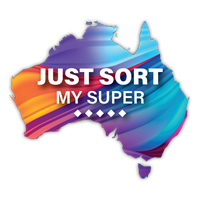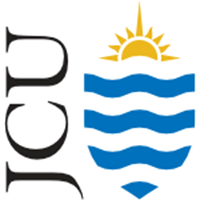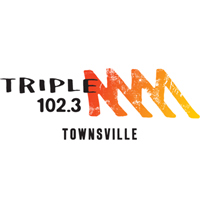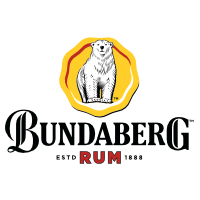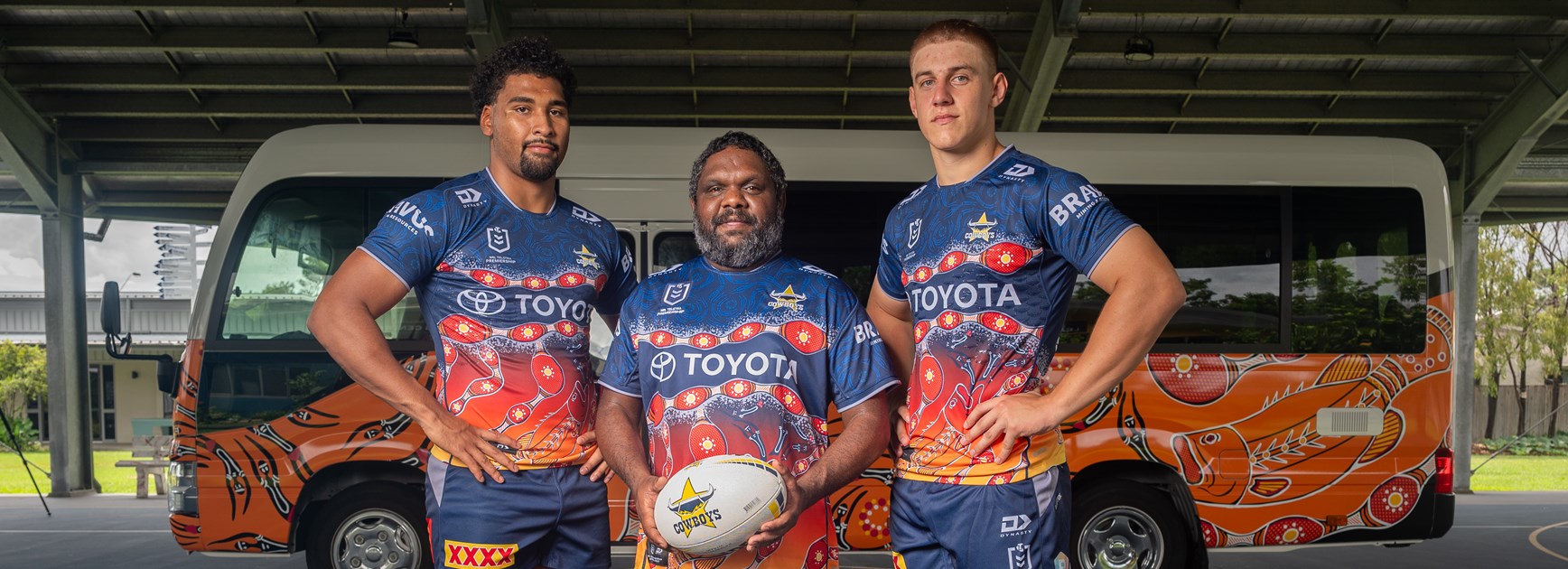
The North Queensland Toyota Cowboys 2024 Indigenous jersey has been unveiled, underpinned by a traditional tale from the Cooktown and Hopevale region of Far North Queensland and inspiring a unique collaboration.
Nhinhinhi Gurra Bamawi Guugu (how the giant Nhinhinhi fish changed the languages), designed by NRL Cowboys House staff member Bradley Michael, features on the jersey to be worn during Deadly Choices Round at Queensland Country Bank Stadium on Friday 24 May against Wests Tigers.
The design and its story carry significant meaning, including values of respecting and learning people’s culture, community, family and values.
The jersey was officially launched at NRL Cowboys House, with North Queensland Cowboys Kaiden Lahrs and Jamal Shibasaki and artist Michael first to wear the design alongside an eye-catching inclusion in this year’s Cowboys Indigenous range, the ‘Nhinhinhi’-inspired Toyota Coaster.
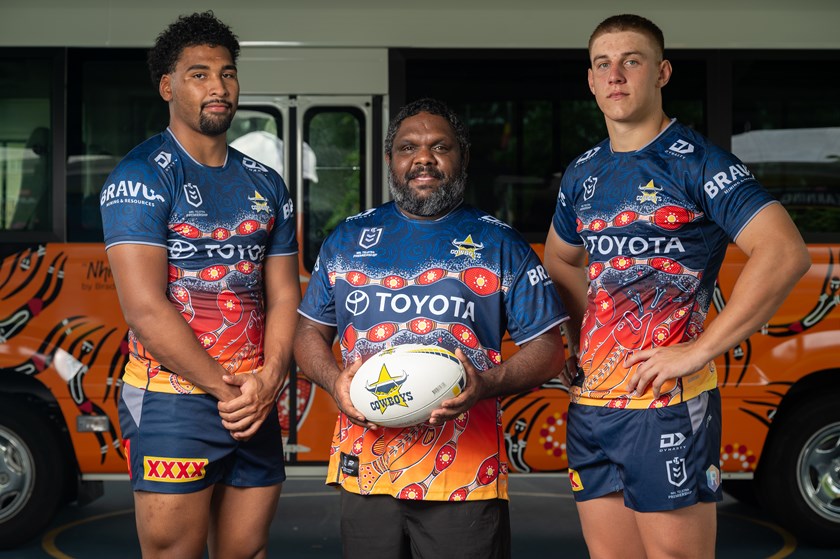
The 22-seat Coaster, donated by Toyota, provides essential daily transportation for NRL Cowboys House boarding students and now features the striking design, bringing Michael’s art to the streets and communities of Townsville.
Michael was raised by a Balnggarrawarra father and a mother from the Nugal Clan from the Guugu Yimithirr speaking people and embodies a rich cultural heritage deeply rooted in his Indigenous background.
His design tells the creation story of Nhinhinhi, a great giant Queensland Groper, in a traditional story passed down to him by his grandfather, Tulo Gordon.
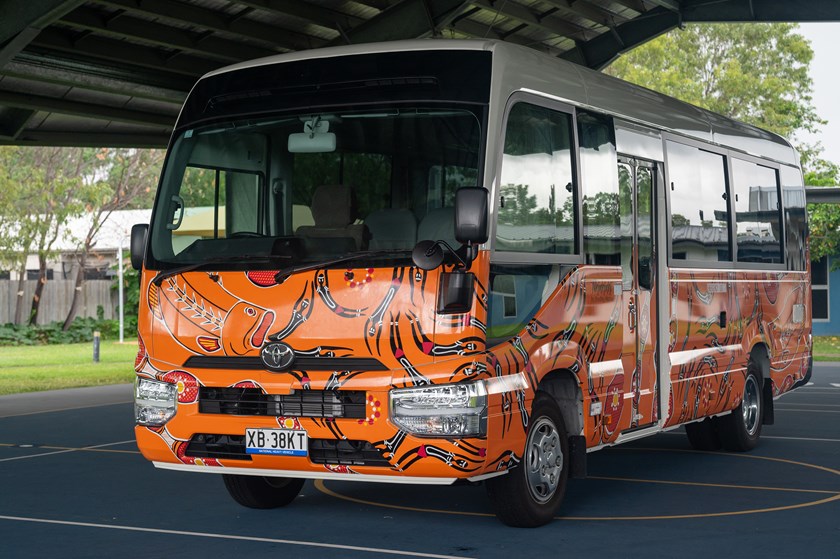
“The story place on our country – there are hundreds of cars that pass by the area each day, but most people would not know that the story existed or was about this area,” Michael said.
“My grandfather’s connection to the story is because it was from his traditional homeland and my grandfather was a storyteller. This story was passed down to him from his elders and then from him to my mum and us.
“I believe it is important for my generation and the ones to follow to know this story and be able to identify the area the story comes from.”
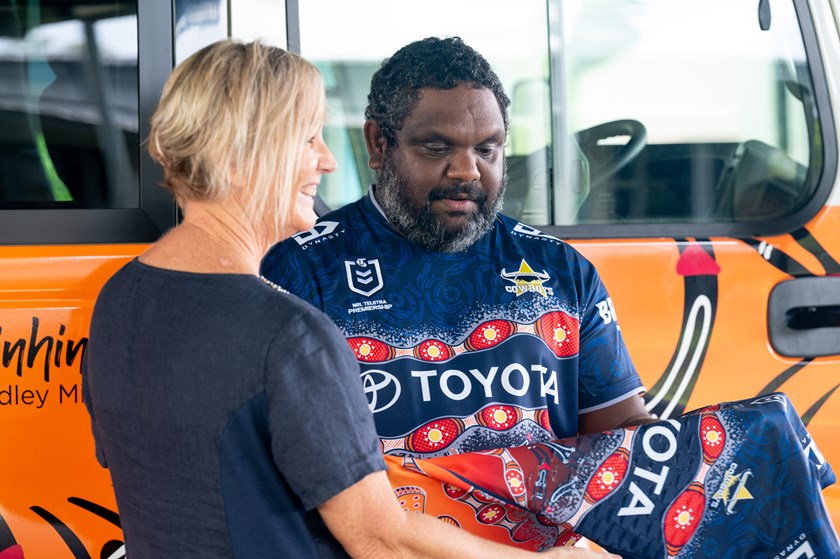
Toyota Australia Chief Marketing Officer, Vin Naidoo said Toyota’s support underscores their commitment to supporting and inspiring communities across Australia through the power of diversity, inclusion, unity and pride.
“The Toyota-donated Coaster will not only assist with the transportation of boarding students but will make education and training more accessible to young First Nations communities, creating a lasting positive impact for years to come,” he said.
“Toyota deeply appreciates the rich cultural narrative woven into Bradley Michael's 2024 Indigenous design, and its presence on the bus will provide a daily reminder to over 100 First Nations students of their heritage and values, fostering a sense of belonging and pride.
“We are immensely proud to be partnering with NRL Cowboys House to foster communities and the game from the ground up.”
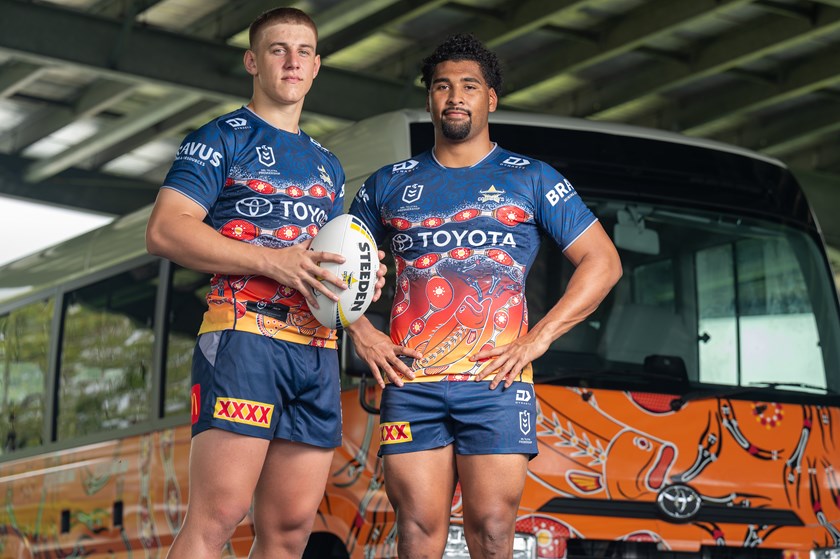
Cowboys Chief Community and Government Relations Officer Fiona Pelling said the club’s embrace of the Nhinhinhi design showed a unified connection to recognising and honouring the contribution of Indigenous people to the community and rugby league across North Queensland.
“The Cooktown and Hopevale area is such a beautiful part of Far North Queensland and we’re proud to wear and carry this traditional story from the region in 2024,” she said.
“We have a long history of hosting boarding students from Cooktown and Hopevale at NRL Cowboys House while our school community programs including Try for 5! are delivered to communities throughout that area.
“We’re proud to have continually provided artists across North Queensland with a platform to showcase their art and local North Queensland stories on our Indigenous jerseys for more than a decade and look forward to representing another valued part of the North for Deadly Choices Round (NRL Indigenous Round).”
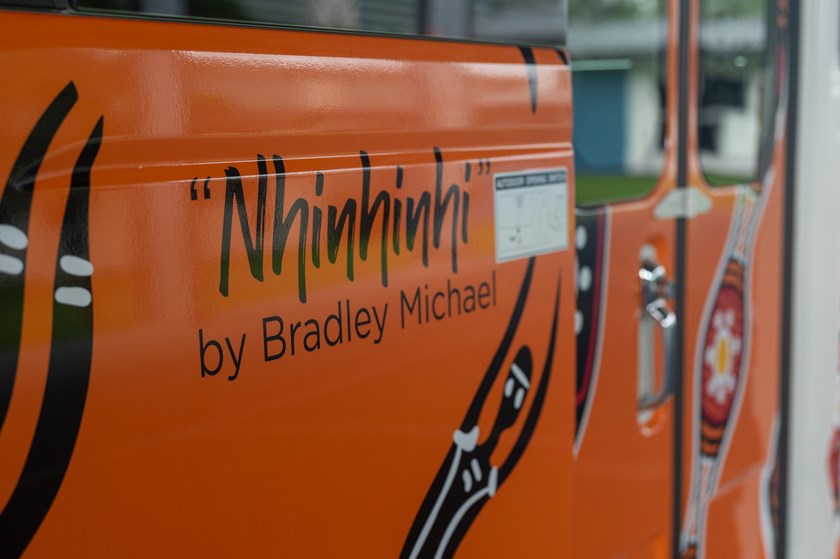
The Cowboys 2024 Indigenous jersey is available for pre-order at the Cowboys Team Shop, in store or online at cowboysteamshop.com.au.
The ‘Nhinhinhi’ design will feature across the 2024 Indigenous range, including the official NRL Cowboys House polo, Deadly Choices training tee and related program apparel.
The House polo will be available in coming weeks exclusively through the Team Shop, with proceeds going to the Cowboys Community Foundation, thanks to Cowboys Leagues Club.
About the artist
Bradley Michael, hailing from the Cooktown and Hopevale area, embodies a rich cultural heritage deeply rooted in his Indigenous background.
Raised by a Balnggarrawarra father and a mother from the Nugal Clan from the Guugu Yimithirr speaking people, Bradley's upbringing was steeped in tradition.
He has a profound appreciation for crafting traditional artefacts such as didgeridoos, spears, woomeras, and nulla-nullas, eagerly passing down these skills to the next generation.
Influenced heavily by his parents, Bradley learned the art of painting from his mother, often accompanying his parents on bush trips to collect materials for their artworks and grew up watching them both paint.
Starting with natural ochres and later transitioning to acrylics, Bradley's paintings vividly narrate stories of his heritage with x-ray style influences, drawing inspiration from his father's country and the intricate rock art galleries.
His artistic journey began with painting, and he has showcased his creations at the esteemed Laura Dance Festival, reflecting his dedication to preserving and celebrating Indigenous culture through his art.
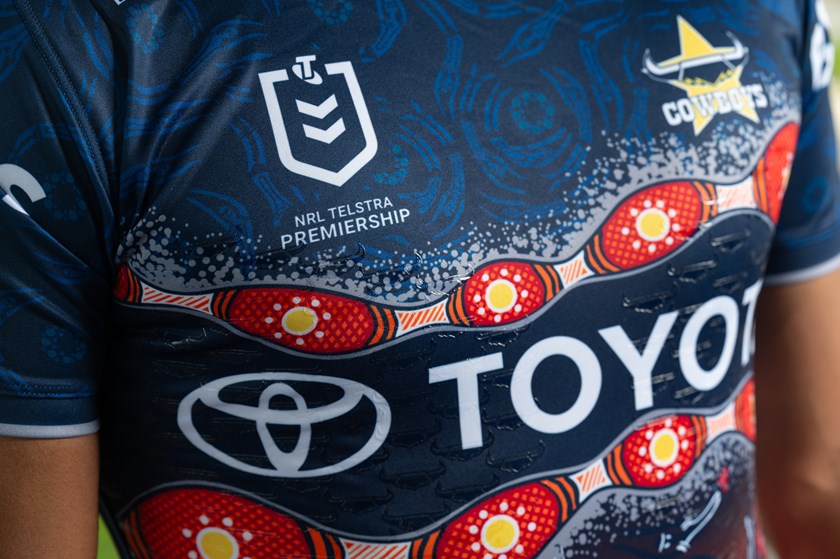
2024 COWBOYS INDIGENOUS DESIGN STORY
'Nhinhinhi Gurra Bamawi Guugu', as told by Bradley Michael’s grandfather Tulo Gordon.
All the Aboriginal people, a long time ago, used to share a single language.
At one point, they decided to call each other together for a big dance. It was south of Hopevale, at Mugayan. That was the place. They called all the people together from the east, from the west, from the north and from the south. They formed a big mob all gathered together to have their dance.
The people used to go out hunting of a daytime. Some would spear game for meat. Others went for bush tucker, or to dig yams. They would take honey back to the camp. They would sit down to cook the meat and yams. They would have a big feed: sit and eat and eat and eat.
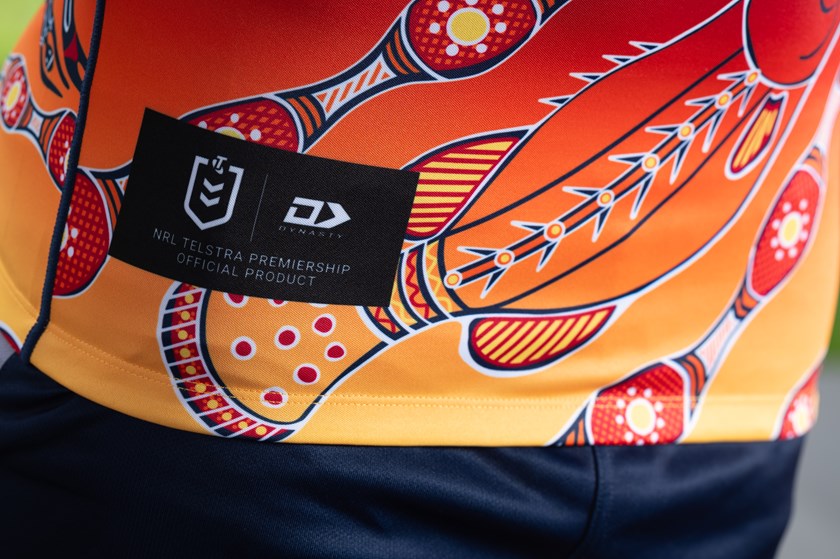
When their bellies were full, they would get up and start the dance. The next night, and the next night, they would dance and dance. Night after night they danced.
They didn’t know – they were unaware as they danced – that a huge giant groper – a nhinhinhi or marrboarrgo – had come up from the ocean, out of the east. It came along underground towards the lagoon where all those tribes were having their dance. When it got there, it opened its gigantic mouth, rose up out of the water and swallowed the whole jolly lot of them.
Then that giant fish turned around and headed east again, travelling underground. It went back into the ocean. For two months that groper stayed out east in the sea, with all the people inside of him. Then he came back again from the east, the same way, travelling underground. He got to the lagoon, opened his mouth and vomited all the people out again.
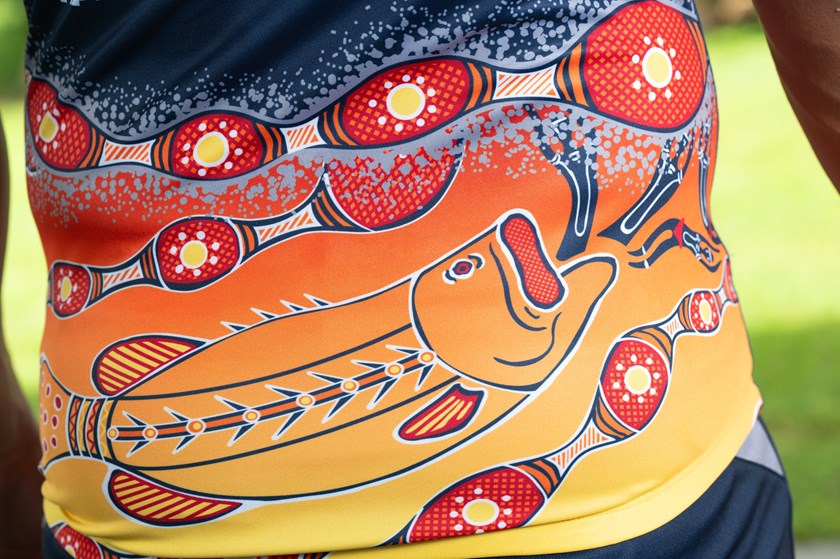
The people jumped out onto the ground. But they found that they were all speaking different languages. One person would talk one way, the next person another way and the next would talk still another way. One person couldn’t understand another’s language, because each spoke a different way.
Just like people nowadays. We speak different kinds of languages right up until today.
Now, this was at the place Ngurrayin, a big lagoon. It’s also called Mugayan, part of the Nugal clan area. That’s what the old people used to call it. (People call it Barrow’s Lagoon in English.) The old people say that seawater comes underground from the ocean and holds up the water level in the lagoon. Even in the dry season, it never dries up. It just stays the way it is.





